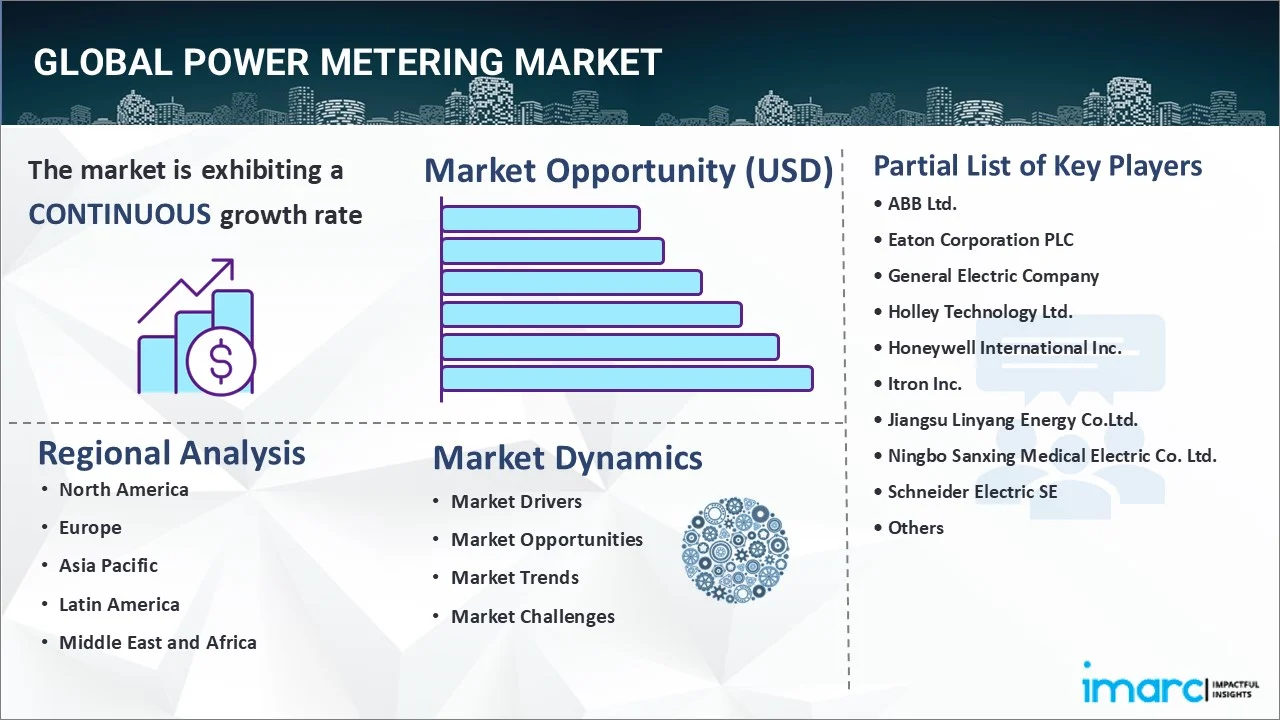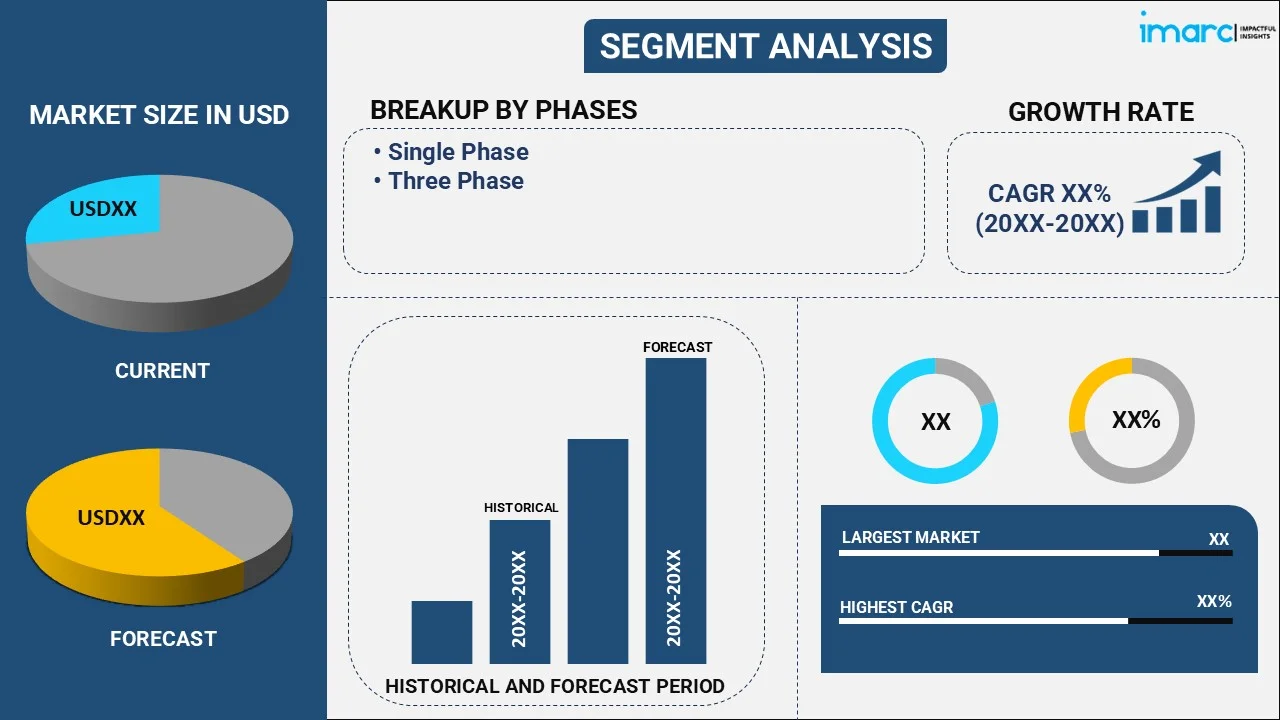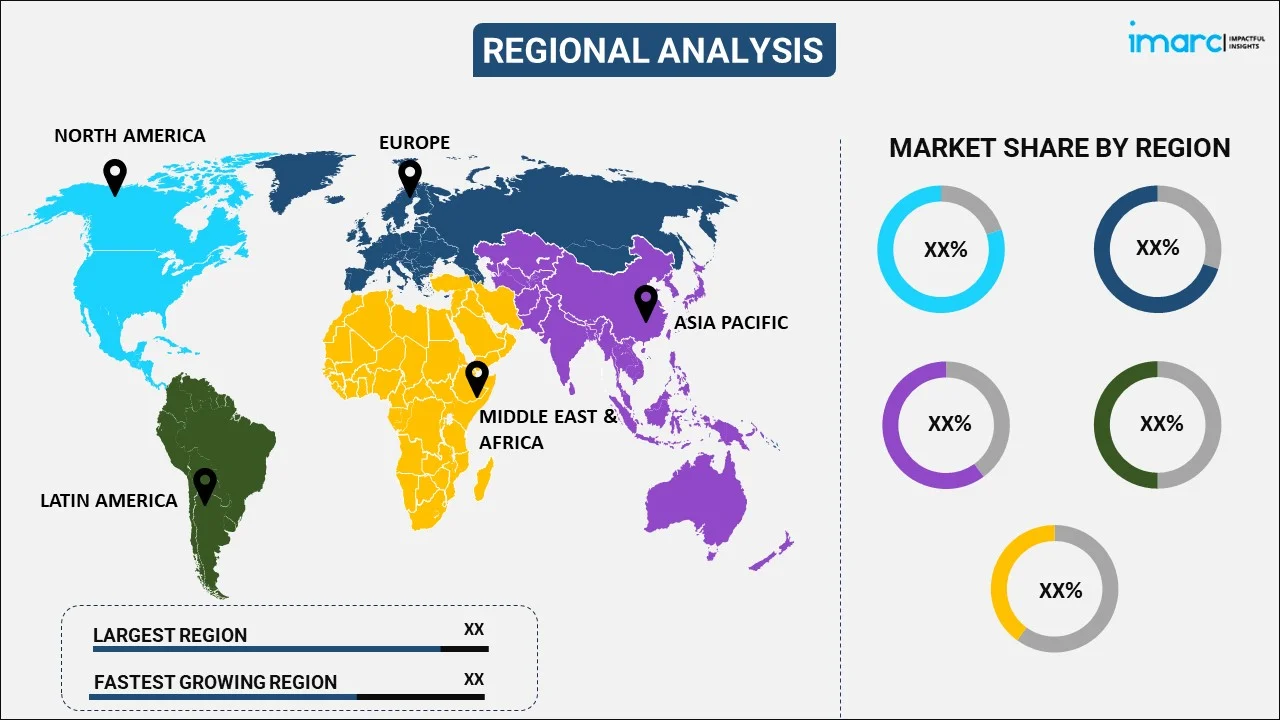
Power Metering Market Report by Phase (Single Phase, Three Phase), Technology (Analog Meters, Digital Meters, Smart Meters), End Use (Residential, Commercial, Industrial), and Region 2025-2033
Market Overview:
The global power metering market size reached USD 19.2 Billion in 2024. Looking forward, IMARC Group expects the market to reach USD 28.2 Billion by 2033, exhibiting a growth rate (CAGR) of 4% during 2025-2033. The increasing energy efficiency initiatives, rapid technological advancements, growing industrialization, rising consumer awareness about sustainability, the integration of renewable energy sources, and deregulation in energy markets are some of the major factors propelling the market.
|
Report Attribute
|
Key Statistics
|
|---|---|
|
Base Year
|
2024 |
|
Forecast Years
|
2025-2033
|
|
Historical Years
|
2019-2024
|
| Market Size in 2024 | USD 19.2 Billion |
| Market Forecast in 2033 | USD 28.2 Billion |
| Market Growth Rate (2025-2033) | 4% |
Power metering is the process of measuring the electrical energy consumed or produced by a facility, system, or piece of equipment. Utilizing specialized devices known as power meters, this practice is currently serving as an essential tool for both residential and commercial entities. Power metering provides real-time data by continuously monitoring parameters like voltage, current, and power factor, power metering that aids in optimizing energy usage. It also assists in identifying inefficiencies, thereby enabling corrective actions to reduce energy costs and carbon footprint. Additionally, power metering is instrumental in load management, helping organizations to allocate energy resources more effectively. It also plays a pivotal role in predictive maintenance, as irregularities in power consumption can indicate potential issues in electrical systems. Overall, power metering is a foundational element in modern energy management strategies, contributing to sustainability and operational excellence.

The growing consumer awareness about sustainable practices and the benefits of energy conservation is one of the major factors propelling the market growth. Consumers are becoming increasingly knowledgeable about the environmental and financial implications of their energy usage due to easy accessibility to information. This heightened awareness is facilitating the demand for power metering solutions that offer detailed insights into consumption patterns. Additionally, the push for renewable energy integration is also acting as a catalyst for the power metering market. Renewable energy power plants like wind and solar require sophisticated metering systems to manage the complexities of energy flow and storage. These meters not only help in maximizing the efficiency of renewable energy systems but also facilitate grid stability. Furthermore, the deregulation of energy markets in various regions is creating a competitive landscape, encouraging providers to adopt advanced metering infrastructure for better customer service and accurate billing. The combination of consumer awareness, renewable energy integration, and market deregulation is thus synergistically propelling the global power metering market toward sustained growth.
Power Metering Market Trends/Drivers:
Energy Efficiency Initiatives
One of the primary drivers of the global power metering market is the increasing focus on energy efficiency. Governments and organizations across the globe are currently implementing policies and regulations aimed at reducing energy consumption and minimizing environmental impact. Power meters are essential tools in these initiatives, providing the data needed to identify wasteful practices and optimize energy usage. As a result, there is a growing demand for advanced metering technologies that offer real-time monitoring and analytics capabilities. These devices not only help in achieving regulatory compliance but also contribute to significant cost savings over time.
Technological Advancements
The rapid advancements in technology are another significant driver in the power metering market. Innovations such as smart meters, which offer remote monitoring and control functionalities, are gaining traction. These devices are equipped with communication modules that allow seamless data transmission to centralized systems, enabling more accurate billing and efficient energy management. The integration of Internet of Things (IoT) and artificial intelligence (AI) technologies further enhances the capabilities of these meters, making them more appealing to both residential and commercial consumers.
Growing Industrialization
The surge in industrial activities globally is contributing to an increased demand for power metering solutions. As industries expand, the need for reliable and efficient energy management becomes critical. Power meters are indispensable in monitoring and controlling the energy consumption of industrial machinery and systems. They help in load balancing, predictive maintenance, and ensuring the optimal performance of electrical systems. With industries striving for operational excellence and sustainability, the role of power metering in industrial settings is becoming increasingly important.
Power Metering Industry Segmentation:
IMARC Group provides an analysis of the key trends in each segment of the global power metering market report, along with forecast at the global, regional and country levels from 2025-2033. Our report has categorized the market based on phase, technology and end use.
Breakup by Phase:

- Single Phase
- Three Phase
Single phase accounts for the majority of the market share
The report has provided a detailed breakup and analysis of the market based on the phase. This includes single phase and three phase. According to the report, single phase represented the largest segment.
The single-phase segment holds the largest share in the power metering market primarily due to its widespread application in residential and small commercial settings. Single-phase power meters are simpler in design, more cost-effective, and easier to install compared to their three-phase counterparts. These attributes make them highly suitable for households and small businesses where energy requirements are relatively lower. Additionally, the surge in smart home technologies and the increasing adoption of energy-efficient appliances are contributing to the demand for single-phase meters that can offer real-time monitoring and analytics. As residential consumers become more energy-conscious, the need for reliable and affordable metering solutions grows, further solidifying the dominant position of single-phase meters in the market. Overall, their versatility, cost-effectiveness, and suitability for lower energy consumption applications make single-phase power meters the largest segment in the market.
Breakup by Technology:
- Analog Meters
- Digital Meters
- Smart Meters
A detailed breakup and analysis of the market based on the technology has also been provided in the report. This includes analog, digital, and smart meters.
Analog meters, also known as electromechanical meters, are the traditional form of power metering and are used in older installations and rural areas where the requirements for real-time data and remote monitoring are less critical. While they are cost-effective and robust, analog meters lack the advanced features and data analytics capabilities that are increasingly demanded in modern energy management systems.
Digital meters offer a step up from analog meters by providing more accurate readings and some level of data analysis. These meters are commonly used in commercial settings and newer residential installations where higher accuracy is required but without the need for extensive data analytics or remote monitoring. Digital meters are gaining market share due to their balance between cost and functionality, serving as a transitional technology for many users.
Smart meters represent the most advanced segment in power metering technology and are rapidly gaining market share. Equipped with communication modules, these meters enable real-time monitoring, remote control, and detailed analytics. They are highly compatible with modern energy management systems and are instrumental in smart grid implementations. The growing focus on energy efficiency, real-time data, and the incorporation of renewable energy sources is driving the adoption of smart meters globally.
Breakup by End Use:
- Residential
- Commercial
- Industrial
Residential represents the leading market segment
The report has provided a detailed breakup and analysis of the market based on the end use. This includes residential, commercial, and industrial. According to the report, residential represented the largest segment.
The residential sector stands as the largest end-user in the power metering market, primarily due to the sheer volume of households requiring energy metering solutions. Unlike industrial or commercial settings, where a single meter can often monitor a large facility, residential applications usually necessitate one meter per household, significantly increasing the total number of units needed. Additionally, the rise in smart home technologies and consumer awareness about energy conservation is fueling the demand for advanced metering solutions in residential settings. Homeowners are increasingly seeking real-time data to manage their energy consumption more efficiently, thereby reducing costs and minimizing environmental impact. Government initiatives aimed at energy conservation also often target residential consumers, offering incentives for the adoption of energy-efficient technologies, including advanced metering systems. Overall, the high number of residential units coupled with growing consumer awareness and supportive government policies make the residential sector the largest end-user in the power metering market.
Breakup by Region:

- North America
- United States
- Canada
- Asia-Pacific
- China
- Japan
- India
- South Korea
- Australia
- Indonesia
- Others
- Europe
- Germany
- France
- United Kingdom
- Italy
- Spain
- Russia
- Others
- Latin America
- Brazil
- Mexico
- Others
- Middle East and Africa
Asia Pacific leads the market, accounting for the largest power metering market share
The market research report has also provided a comprehensive analysis of all the major regional markets, which include North America (the United States and Canada); Asia Pacific (China, Japan, India, South Korea, Australia, Indonesia, and others); Europe (Germany, France, the United Kingdom, Italy, Spain, Russia, and others); Latin America (Brazil, Mexico, and others); and the Middle East and Africa. According to the report, Asia Pacific accounted for the largest market share.
Asia Pacific holds the distinction of being the largest regional market for power metering, driven by a combination of factors such as rapid industrialization, urbanization, and population growth. Countries like India and China are undergoing significant economic expansion, leading to increased energy consumption across both industrial and residential sectors. This surge in energy demand necessitates robust metering solutions for effective management and distribution. Additionally, governments in the region are actively promoting energy efficiency initiatives and are investing in upgrading the existing electrical infrastructure. The incorporation of sustainable sources of energy into the grid is also gaining momentum, further necessitating advanced metering technologies. Moreover, the relatively lower penetration of advanced metering systems in the region offers a substantial growth opportunity for market players. All these factors collectively contribute to Asia Pacific's dominant position in the global power metering market.
Competitive Landscape:
Leading companies in the global power metering market are engaging in research and development (R&D) to introduce innovative and more efficient metering solutions. Many are focusing on the integration of machine learning (ML), the Internet of Things (IoT) sensors, and artificial intelligence (AI) to enhance the capabilities of their products. These technologies enable real-time monitoring, predictive analytics, and remote-control functionalities, offering a competitive edge in the market. Strategic partnerships and collaborations are also common as companies seek to expand their geographical reach and diversify their product portfolios. Additionally, mergers and acquisitions are being pursued to consolidate market positions and acquire technological expertise. Companies are also investing in customer education and after-sales services to build long-term relationships and ensure customer retention. Regulatory compliance and sustainability are other key focus areas, with many players offering solutions that help consumers meet energy efficiency standards and reduce their carbon footprint.
The market research report has provided a comprehensive analysis of the competitive landscape in the market. Detailed profiles of all major companies have also been provided. Some of the key players in the market include:
- ABB Ltd.
- Eaton Corporation PLC
- General Electric Company
- Holley Technology Ltd.
- Honeywell International Inc.
- Itron Inc.
- Jiangsu Linyang Energy Co.Ltd.
- Ningbo Sanxing Medical Electric Co. Ltd.
- Schneider Electric SE
- Sensus USA Inc. (Xylem Inc.)
- Siemens AG
- Toshiba Corporation
Recent Developments:
- In August 2022, ABB India launched a new series of smart meters for efficient energy management in India. The range covers low to medium voltage applications in industrial, commercial, and residential sectors. The meters can measure basic electrical parameters as well as advanced power quality parameters.
- In June 2020, Schneider Electric SE introduced EasyLogic PM2000 series power meters for energy cost management applications in commercial buildings.
- In December 2022, Siemens AG won a new contract to establish a distribution management system and smart metering infrastructure in Egypt.
Power Metering Market Report Scope:
| Report Features | Details |
|---|---|
| Base Year of the Analysis | 2024 |
| Historical Period | 2019-2024 |
| Forecast Period | 2025-2033 |
| Units | Billion USD |
| Scope of the Report | Exploration of Historical Trends and Market Outlook, Industry Catalysts and Challenges, Segment-Wise Historical and Future Market Assessment:
|
| Phases Covered | Single Phase, Three Phase |
| Technologies Covered | Analog Meters, Digital Meters, Smart Meters |
| End Uses Covered | Residential, Commercial, Industrial |
| Regions Covered | Asia Pacific, Europe, North America, Latin America, Middle East and Africa |
| Countries Covered | United States, Canada, Germany, France, United Kingdom, Italy, Spain, Russia, China, Japan, India, South Korea, Australia, Indonesia, Brazil, Mexico |
| Companies Covered | ABB Ltd., Eaton Corporation PLC, General Electric Company, Holley Technology Ltd., Honeywell International Inc., Itron Inc., Jiangsu Linyang Energy Co.Ltd., Ningbo Sanxing Medical Electric Co. Ltd., Schneider Electric SE, Sensus USA Inc. (Xylem Inc.), Siemens AG, Toshiba Corporation etc. |
| Customization Scope | 10% Free Customization |
| Post-Sale Analyst Support | 10-12 Weeks |
| Delivery Format | PDF and Excel through Email (We can also provide the editable version of the report in PPT/Word format on special request) |
Key Benefits for Stakeholders:
- IMARC’s industry report offers a comprehensive quantitative analysis of various market segments, historical and current market trends, market forecasts, and dynamics of the power metering market from 2019-2033.
- The research report provides the latest information on the market drivers, challenges, and opportunities in the global power metering market.
- The study maps the leading, as well as the fastest-growing, regional markets. It further enables stakeholders to identify the key country-level markets within each region.
- Porter's five forces analysis assist stakeholders in assessing the impact of new entrants, competitive rivalry, supplier power, buyer power, and the threat of substitution. It helps stakeholders to analyze the level of competition within the power metering industry and its attractiveness.
- Competitive landscape allows stakeholders to understand their competitive environment and provides an insight into the current positions of key players in the market.
Key Questions Answered in This Report
The global power metering market was valued at USD 19.2 Billion in 2024.
We expect the global power metering market to exhibit a CAGR of 4% during 2025-2033.
The development of advanced power metering systems, which are connected via web apps to laptops or smartphones, to simplify the operation and enable remote monitoring, is currently driving the global power metering market.
The sudden outbreak of the COVID-19 pandemic had led to the implementation of stringent lockdown regulations across several nations resulting in subsequent effects on energy cost across residential, commercial, and industrial sectors.
Based on the phase, the global power metering market has been categorized into single phase and three phase. Currently, single phase power meter represents the majority of the total market share.
Based on the end use, the global power metering market can be bifurcated into residential, commercial, and industrial. Among these, the residential sector accounts for the largest market share.
On a regional level, the market has been classified into North America, Asia Pacific, Europe, Latin America, and Middle East and Africa, where Asia Pacific currently dominates the global market.
Some of the major players in the global power metering market include ABB Ltd., Eaton Corporation PLC, General Electric Company, Holley Technology Ltd., Honeywell International Inc., Itron Inc., Jiangsu Linyang Energy Co.Ltd., Ningbo Sanxing Medical Electric Co. Ltd., Schneider Electric SE, Sensus USA Inc. (Xylem Inc.), Siemens AG, and Toshiba Corporation.
Need more help?
- Speak to our experienced analysts for insights on the current market scenarios.
- Include additional segments and countries to customize the report as per your requirement.
- Gain an unparalleled competitive advantage in your domain by understanding how to utilize the report and positively impacting your operations and revenue.
- For further assistance, please connect with our analysts.
 Inquire Before Buying
Inquire Before Buying
 Speak to an Analyst
Speak to an Analyst
 Request Brochure
Request Brochure
 Request Customization
Request Customization




.webp)




.webp)












